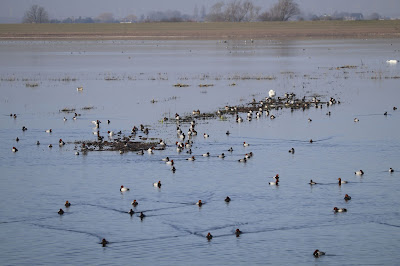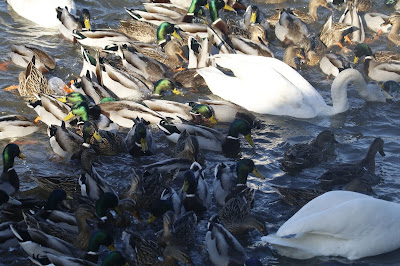A thousand GOLDEN PLOVER took to the air, twisting and swirling as one great flock in the skies over Lady Fen. Was it caused by a bird of prey, or just the fact that these birds are so naturally jittery, its hard to tell. As they settled back down they would turn a whole field golden before returning to the air again.
This is just one of the bird spectacles to be witnessed at the Ouse Washes, the best inland bird watching site in the country. A long, thin area of seasonally flooded wetland, this place attracts tens of thousands of birds in winter. This isn't something that's common in our country, even in Europe, this place is of international importance for its water birds. With the wet winter the washes have had wall to wall flooding, creating a giant lake, but the water has receded somewhat, with banks and islands and tufts of grass emerging above the surface, which is more attractive to birds.
POCHARD
Welney was the first port of call. This reserve protects the north of the washes just over the border in Norfolk. Love it or loathe it, this place has some of the best amentites for any nature reserve in the country. A great café. A heated observatory looking out over the washland. A swan feed. This might put off the purists, but it gets people closer to nature, including a school visit today. It allows those who might be interested in nature to witness a spectacle first hand. Who could disagree with that.
As the water recedes new islands are beginning to appear above the water
The nice heated observatory looked out over the washlands, in front of which were large numbers of WHOOPER and MUTE SWANS, as well as a congregation of MALLARDS and POCHARDS. Around midday they did the swan feed, where a man with a wheel barrow full of grain goes out and feeds the wildowl immediately in front of the observatory whilst bird watchers looked on. Whatever you feel about this, it really creates a spectacle. The birds loved it with there being more ducks than water as they wrestled with each other to get to the grain.
A swarm of ducks at the swan feed
There isn't much of a walk at Welney, just a saunter up to some hides to the north and back. Away from the observatory, birds were scattered more thinly over the washes. There were smaller numbers of other DUCK species about, including some PINTAIL, and a male GOLDENEYE was seen in flight. Overall the WIGEON was the commonest duck, numbering in the thousands as they called the washes home.
More ducks at the swan feed
A female MARSH HARRIER quartered the marshes several times but the ducks sleeping beneath seemed unperturbed by the bird of prey. There was a flock of 150 BLACKWITS roosting on an island and a few REDSHANK may be early returning breeders, whilst there was also five SNIPE on one of the islands, but there were probably more hidden about, as is usual with this species.
It really was a day of quantity, with there being so much about, it just lacked the rare bird to make it extra special, but who knows, nestled within all those duck flocks something unusual was lurking.
It wasn't all about the washalnds. As I drank coffee in the visitors centre, the feeders below were full of small birds, with both TREE and HOUSE SPARROWS feeding, one of the few places in the country where you an compare the two birds side by side. There were also plenty of REED BUNTINGS, feeding below the feeders, it was just such a good place for birds in general.
RSPB Ouse Washes
After the birding intensity of Welney I had some time to head south to the RSPB part of the washes. Along the way the large stretches of arable land held flocks of SWANS, birds that feed out in the fields before roosting back on the washes at dusk.
Although no better nor worse than Welney, things at this reserve weren't so hands on, the birds were more distant, usually congregating on the far side of the washes, in a more natural manner, as they weren't being fed. The reserve access, like Welney, consisted of a walk up the sides of the washes and back, with a lot of hides to visit along the way. Unfortunaelty due to time constarinst I only had an hour to spend at this amazing place, too little time to see all the masses of birds present. Its hard to bring across how much bird life was on the Washes, how difficult it is to describe the sheer scale, what tens of thousands of birds looks like. Its just as difficult to show it in pictures, as you can see.
POCHARDS
The reserve held pretty much the same sort of WILDFOWL as Welney, with the most common species being WIGEON. There were some WHOOPERS, their distinct "whooping" call carrying over the still fenland air, such an amazing sound.
Walking along the river a ghostly shape emerged into view, a BARN OWL quatering low over the other side of the river. A beautiful sight, it flew below the reeds, then came up again, following the river it flew through some trees and then came back on itself, before disappearing into the distance. This bird always adds a sense of mystery to a palce, creates the aura of a wild land, something distant from humanity.
Male REED BUNTING, coming into breeding plumage
As at Welney, there were flocks of REED BUNTINGS, and from an osier bed what must be the earliest time I have heard this birds sing, was a CHIFCHAFF.
I hope this blog has been able to recount what it is like to experience such a large scale of birds. Its not often I come here, and next week it will be back to the local fishing lakes, seeing the odd coot or Canada goose. This has been a long blog - well done for following it to the end. I hope you enjoy my blogs, and maybe you could be inspired to leave a comment sometime.







































